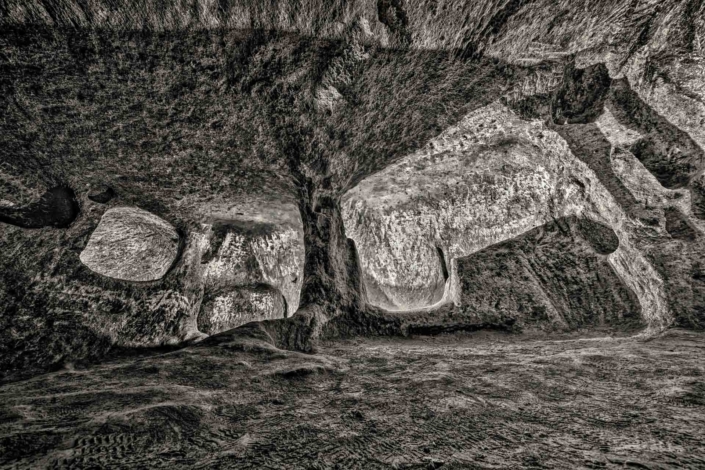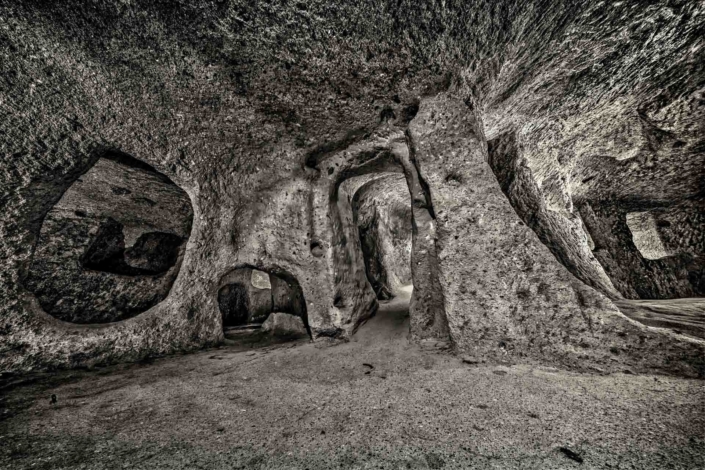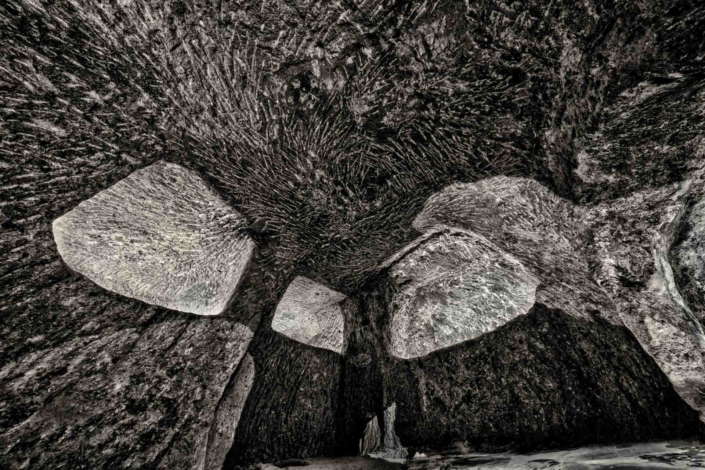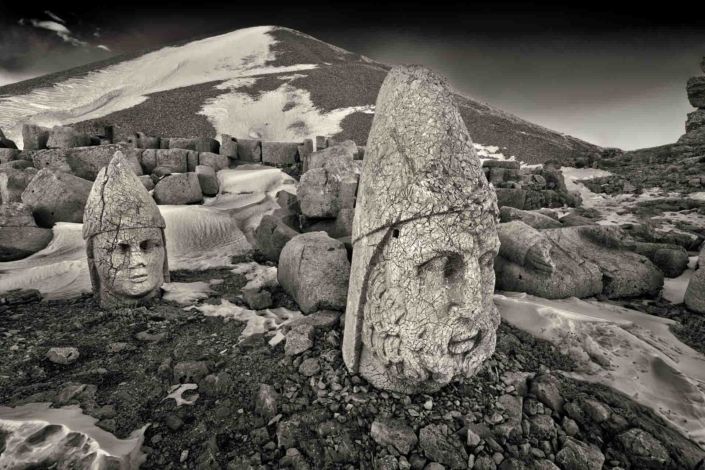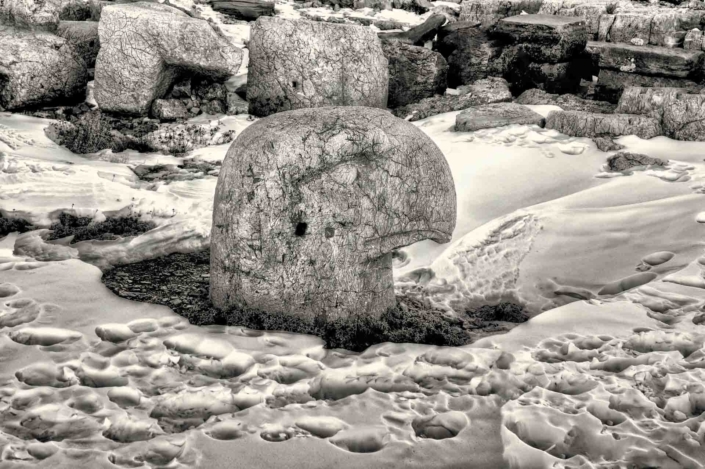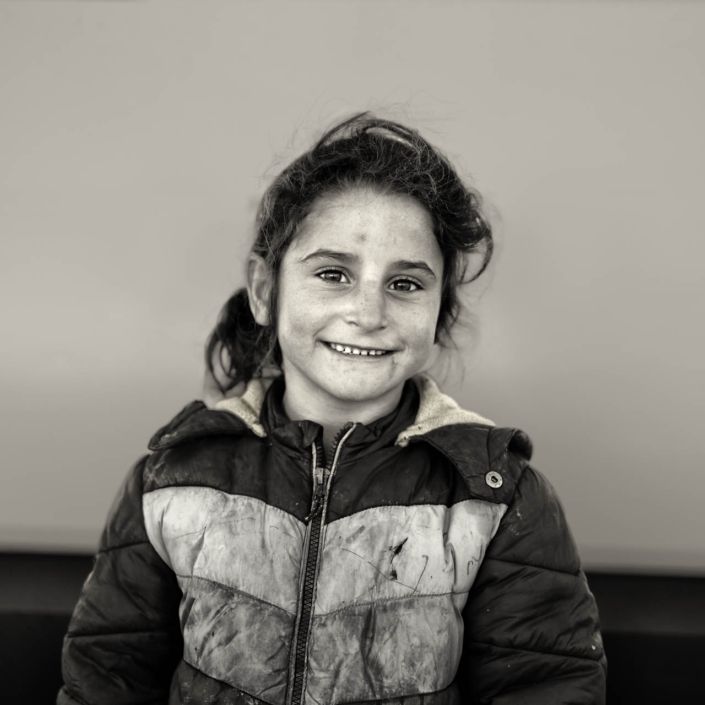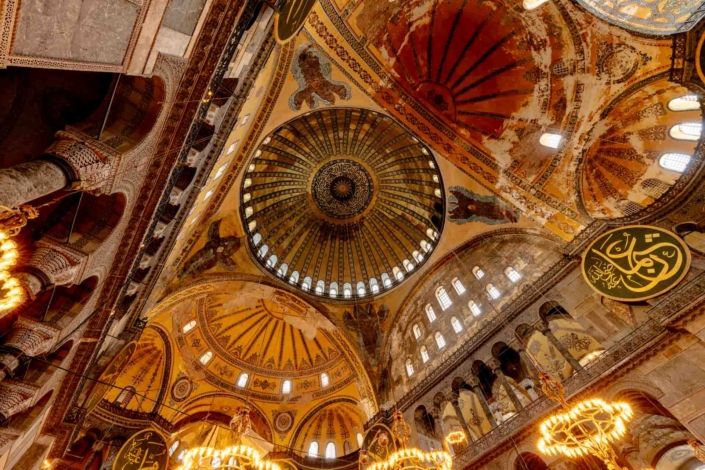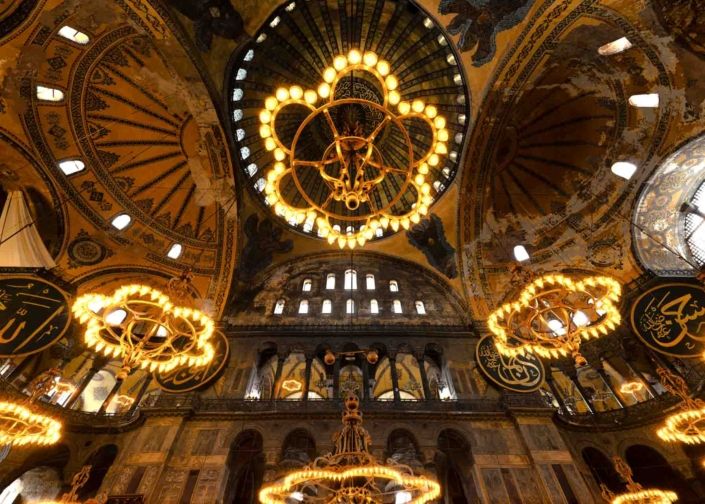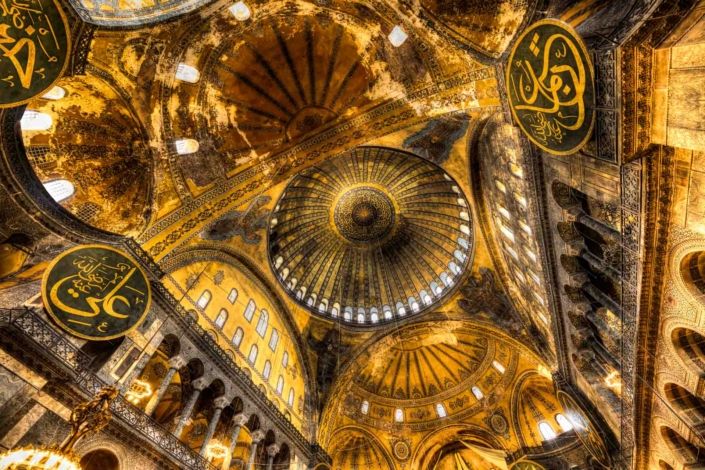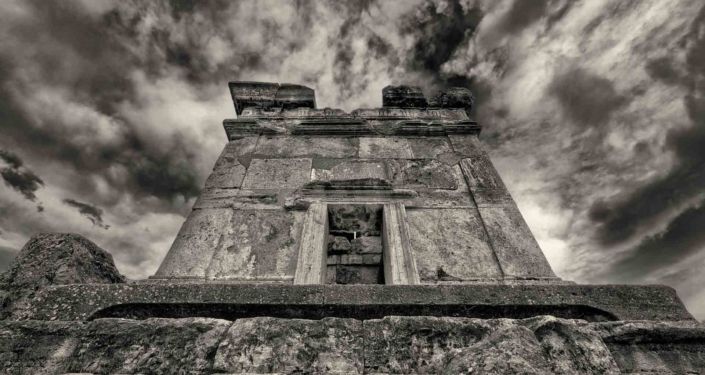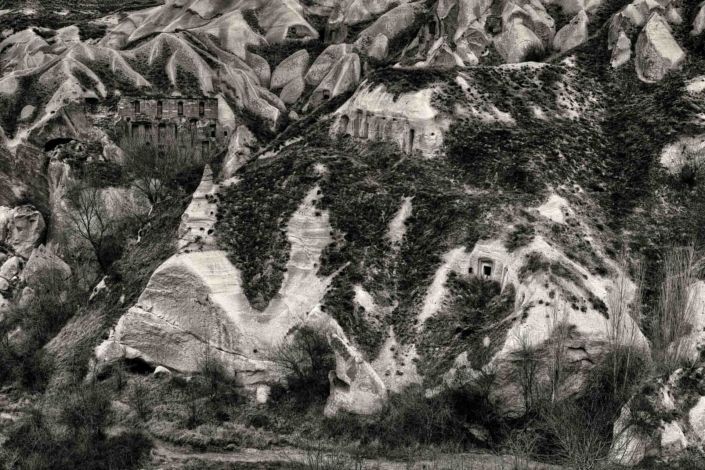Hagia Sophia
The current structure was built by the Byzantine emperor Justinian I as the Christian cathedral of Constantinople for the Byzantine Empire between 532 and 537, and was designed by the Greek geometers Isidore of Miletus and Anthemius of Tralles. It was formally called the Church of God’s Holy Wisdom and upon completion became the world’s largest interior space and among the first to employ a fully pendentive dome. It is considered the epitome of Byzantine architecture and is said to have “changed the history of architecture”. The present Justinianic building was the third church of the same name to occupy the site, as the prior one had been destroyed in the Nika riots. As the episcopal see of the ecumenical patriarch of Constantinople, it remained the world’s largest cathedral for nearly a thousand years, until Seville Cathedral was completed in 1520. Beginning with subsequent Byzantine architecture, Hagia Sophia became the paradigmatic Orthodox church form, and its architectural style was emulated by Ottoman mosques a thousand years later. It has been described as “holding a unique position in the Christian world” and as an architectural and cultural icon of Byzantine and Eastern Orthodox civilization.
The religious and spiritual centre of the Eastern Orthodox Church for nearly one thousand years, the church was dedicated to the Holy Wisdom. It was where the excommunication of Patriarch Michael I Cerularius was officially delivered by Humbert of Silva Candida, the envoy of Pope Leo IX in 1054, an act considered the start of the East–West Schism.
Mount Nemrut
Mount Nemrut mountain in southeastern Turkey, notable for the summit where a number of large statues are erected around what is assumed to be a royal tomb from the 1st century BC. It is one of the highest peaks in the east of the Taurus Mountains. It was designated a UNESCO World Heritage Site in 1987.
In 62 BC, King Antiochus I of Commagene built on the mountain top a tomb-sanctuary flanked by huge statues 8–9-metre high of himself, two lions, two eagles, and various composite Greek and Iranian gods, such as Heracles-Artagnes-Ares, Zeus-Oromasdes, and Apollo-Mithras-Helios-Hermes. When constructing this pantheon, Antiochus drew heavily from Parthian and Armenian traditions in order to reinvigorate the religion of his ancestral dynasty. The statues were once seated, with names of each god inscribed on them. At some point the heads of the statues were removed from their bodies, and they are now scattered throughout the site.
The pattern of damage to the heads (notably to noses) suggests that they were deliberately damaged as a result of iconoclasm. The statues have not been restored to their original places. The site also preserves stone slabs with bas-relief figures that are thought to have formed a large frieze. These slabs, or stelae, depict Antiochus’ Greek and Persian ancestors.
The same statues and ancestors found throughout the site can also be found on the tumulus at the site, which is 49 metres tall and 152 m in diameter. It is possible that the tumulus of loose rock was devised to protect a tomb from robbers, since any excavation would quickly fill in. The statues appear to have Greek-style faces, but Persian clothing and hair-styling.
The western terrace contains a large slab with a lion, showing an arrangement of stars and the planets Jupiter, Mercury, and Mars. The composition was taken to be a chart of the sky on 7 July 62 BCE. This may be an indication of when construction began on this monument. The eastern portion is well preserved, being composed of several layers of rock, and a path following the base of the mountain is evidence of a walled passageway linking the eastern and western terraces. Possible uses for this site are thought to have included religious ceremonies, owing to the astronomical and religious nature of the monument.
The arrangement of such statues is known by the term hierothesion. Similar arrangements have been found at Arsameia on Nymphaios at the hierothesion of Antiochus’ father, Mithridates I Callinicus.
City of 1,001 Churches
Ani is a ruined medieval Armenian city now situated in Turkey’s province of Kars, next to the closed border with Armenia. Between 961 and 1045, it was the capital of the Bagratid Armenian kingdom that covered much of present-day Armenia and eastern Turkey. The iconic city was often referred to as the “City of 1,001 Churches,” though the number was significantly less. To date, 50 churches, 33 cave chapels and 20 chapels have been excavated by archaeologists and historians.
Ani stood on various trade routes and its many religious buildings, palaces, and sophisticated fortifications distinguished it from other contemporary urban centers in the Armenian kingdom.
The Süleymaniye Mosque
The Süleymaniye Mosque was commissioned by Suleiman the Magnificent and designed by the imperial architect Mimar Sinan. An inscription specifies the foundation date as 1550 and the inauguration date as 1557. Behind the qibla wall of the mosque is an enclosure containing the separate octagonal mausoleums of Suleiman the Magnificent and his wife Hurrem Sultan (Roxelana). For 462 years, the Süleymaniye Mosque was the largest mosque in the city, until it was surpassed by the Çamlıca Mosque in 2019. The Süleymaniye Mosque is one of the best-known sights of Istanbul, and from its location on the Third Hill, it commands an extensive view of the city around the Golden Horn.
Sultan Suleyman the Magnificent chose the architect Mimar Sinan to create a mosque in memory of his son Şehzade (Crown Prince) Mehmed. Suleyman was so impressed with the ensuing Şehzade Mosque that he asked Sinan to design a mosque for himself too. This mosque would represent the pre-eminence of the Ottoman Empire. In designing the Süleymaniye Mosque, Sinan took inspiration from the Hagia Sophia and the Bayezid II Mosque. The mosque was built on the site of the old palace of Topkapi which was still in use at the time and had to be demolished.
The Arabic inscription above the north portal of the mosque is carved in Thuluth script on three marble panels. It gives a foundation date of 1550 and an inauguration date of 1557. In reality the planning of the mosque began before 1550 and parts of the complex were not completed until after 1557.
The design of the Süleymaniye played on Süleyman’s self-conscious representation of himself as a ‘second Solomon.’ It referenced the Dome of the Rock, which was built on the site of the Temple of Solomon in Jerusalem, as well as Justinian’s boast upon the completion of the Hagia Sophia: “Solomon, I have surpassed thee!”[5] The Süleymaniye asserted Süleyman’s historical importance although it was smaller in size than Hagia Sophia.
The Süleymaniye was damaged in the great fire of 1660 and was restored by Sultan Mehmed IV. Part of the dome collapsed during the earthquake of 1766.
Cappadocia’s Fairy Chimneys
Nestled in the heart of Turkey, Cappadocia is famous for its otherworldly landscapes, inviting viewers to explore its enchanting wonders.
We find ourselves in a mystical morning haze, where the soft light of dawn illuminates the silhouette of a captivating Fairy Chimney. Standing tall against the sky, prominent cracks and crevices tell the story of time’s gentle erosion, giving these ancient formations an intriguing sense of history and resilience.
The labyrinth of Fairy Chimneys reveal the vastness of Cappadocia’s geological secrets. In some photos, the structures appear as whimsical dwellings, inspiring visions of a hidden community of mythical creatures. In others, they seem like ancient sentinels, guarding the secrets buried within the region’s rocky embrace.
The changing seasons provide an ever-changing backdrop for these extraordinary rock formations. In one of the photographs, the Fairy Chimneys are adorned, as if nature herself has decided to paint the landscape . Snow-covered scenes also grace the series, with the Fairy Chimneys transforming into ethereal sculptures, shrouded in a white blanket.
Kaymakli Underground City
The cultural heritage of Cappadocia is Kaymakli Underground City. Carved out of the soft volcanic rock, this ancient underground city dates back more than 3,000 years and is an extraordinary testament to human ingenuity and endurance.
Stretching over several levels, Kaymakli Underground City is a maze of narrow passages, secret chambers, and interconnected tunnels that reaches an astonishing depth of approximately 85 meters. It is believed that the city was built and expanded upon by the early Christians as a sanctuary and shelter during times of persecution.
This subterranean marvel was specifically designed to accommodate a large population, estimated to be around 3,500 people, effectively turning it into an underground metropolis complete with living quarters, storage rooms, churches, wineries, and ventilation shafts. The city‘s sophisticated architectural features include intricate stone carvings, underground wells, and an ingenious labyrinthine design that allowed for easy defensibility. The sheer scale of the underground city, with its vast chambers and interconnecting tunnels, is awe-inspiring. The strategic placement of rooms and passageways demonstrates an advanced understanding of urban planning, highlighting the mastery and resourcefulness of the early inhabitants.




